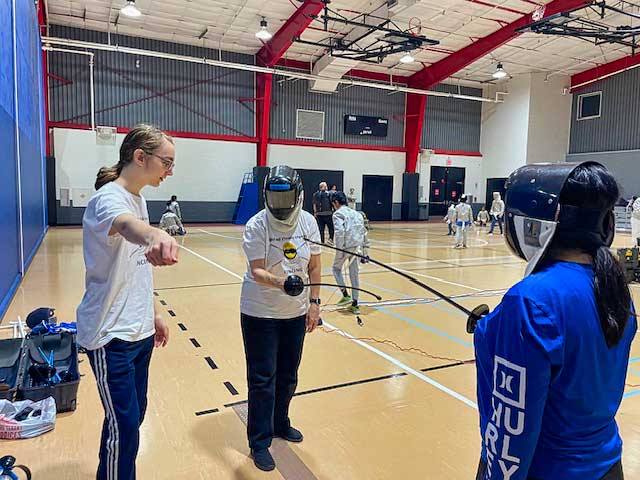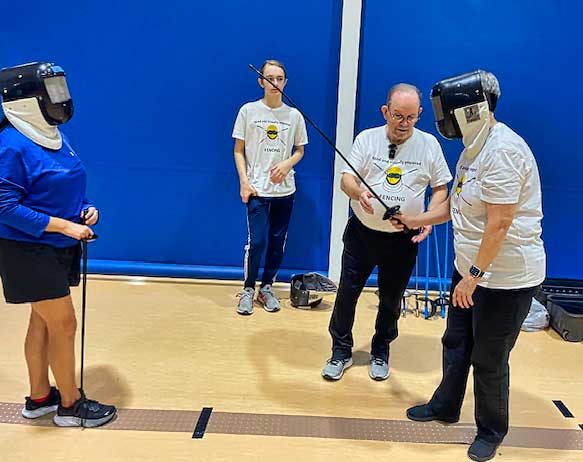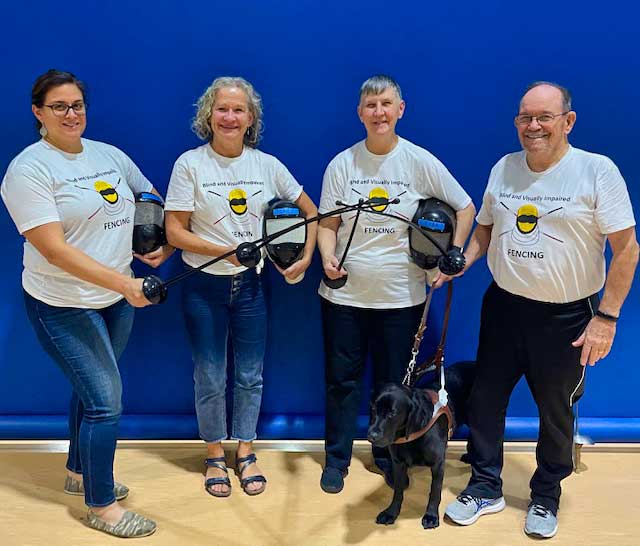The Art of Blind Fencing
 Blind fencing instruction begins! Seen here from left to right are an assistant coach, Pound, and another BVI fencer.In Austin, Texas, an unusual fencing class echoes with the sound of sword engaging with sword. Pat Pound, who has been blind since age 14, is the first student in this class for blind fencers. Together with UAB Low Vision Rehabilitation Graduate Certificate program alumna Regina Budet, OTR, OTD, SCLV, ECHM, she is a driving force in bringing this sport to their local blind and visually impaired community.
Blind fencing instruction begins! Seen here from left to right are an assistant coach, Pound, and another BVI fencer.In Austin, Texas, an unusual fencing class echoes with the sound of sword engaging with sword. Pat Pound, who has been blind since age 14, is the first student in this class for blind fencers. Together with UAB Low Vision Rehabilitation Graduate Certificate program alumna Regina Budet, OTR, OTD, SCLV, ECHM, she is a driving force in bringing this sport to their local blind and visually impaired community.
Blind fencing began as a rehabilitation technique used for World War I veterans blinded during combat. The aim was to help them regain the skills they needed to live independently. Pound first heard about the sport from an acquaintance, also blind, who mentioned that he enjoys—and benefits from—fencing.
A former blindness rehabilitation and disability policy professional, Pound was immediately drawn to the excitement and benefits of blind fencing.
“Fencing has a direct connection to how well blind people do at orientation and mobility,” she says. “It requires you to bend your knees, be on the balls of your feet, and practice, practice, practice. The muscle memory this creates transfers automatically as you move about in the world.”
She reached out to Budet, who was unfamiliar with blind fencing but intrigued by its possibilities for the blind and visually impaired population she works with.
“I’ve experienced the benefits of sports firsthand, and I know that this population has difficulties getting physical activity adapted for them. That was very appealing to me,” says Budet, founder and owner of Austin’s Empower Occupational Therapy.
Building the program
 Coach Murray explains a detail to Pound while the assistant coach and a BVI fencer look on.As Budet learned more about blind fencing, it became clear that it could improve a range of skills for visually impaired people of all ages, including listening, navigation, balance, and coordination. These skills are integral for mobility with a cane as well as for overall spatial awareness and confidence in daily activities.
Coach Murray explains a detail to Pound while the assistant coach and a BVI fencer look on.As Budet learned more about blind fencing, it became clear that it could improve a range of skills for visually impaired people of all ages, including listening, navigation, balance, and coordination. These skills are integral for mobility with a cane as well as for overall spatial awareness and confidence in daily activities.
A fencing program was feasible, she thought, because it wouldn’t require adaptive equipment or large practice spaces. During blind fencing bouts, both participants—pairs of sighted and visually impaired individuals—are blindfolded underneath their fencing masks.
“Blind participants use the same equipment as sighted fencers, who sometimes practice blindfolded to hone their other senses,” Budet says.
She and Pound partnered with Cindy Bachofer, MEd, a low vision specialist at the Texas School for the Blind and Visually Impaired in Austin. It was Bachofer who located Gary Murray, a local fencing coach who was interested in learning to work with blind participants.
“We taught coach about blindness while he taught us all about fencing,” Budet says. Progress came quickly, and in January of this year, just a few months after Budet first learned about blind fencing, Pound faced off with an instructor in the inaugural class.
This video features Coach Murray and blind fencer Rabih Dow, the person who first told Pound about the sport, introducing it to volunteer fencers from local programs for people who are blind and visually impaired.
Extending reach and impact
 The team that made BVI Fencing a reality. Shown from left to right are Budet, Bachofer, Pound, and Murray.The program, now officially called Blind and Visually Impaired (BVI) Fencing, is building momentum through demonstrations at local events and professional conferences. The BVI team is training three sighted teenage volunteers as assistant coaches for students who may never have seen a fencing bout or held a sword.
The team that made BVI Fencing a reality. Shown from left to right are Budet, Bachofer, Pound, and Murray.The program, now officially called Blind and Visually Impaired (BVI) Fencing, is building momentum through demonstrations at local events and professional conferences. The BVI team is training three sighted teenage volunteers as assistant coaches for students who may never have seen a fencing bout or held a sword.
“Coach Murray is also developing a program to train fencing coaches through Zoom on how to work with blind folks,” Budet says. “We want to spread these programs a lot further.”
Blind fencing will get an international stage at the 2024 Summer Paralympic Games in Paris, France, where Murray has arranged for a group of blind fencers from Italy to demonstrate the sport. Wheelchair fencing has been a Summer Paralympic event since 1960, but this will be the first time at these games that blind fencers touch swords to showcase the sport’s inclusivity and adaptability.
“It’s an exciting time,” Pound says. “We’re at the beginning, but there’s so much potential.”
For Budet, the program is about more than teaching fencing, it’s a chance to open up a dynamic sport with many physical and mental benefits to people who are blind and visually impaired.
“Blind fencing involves many cognitive components—it definitely works your brain,” Budet says, while Pound likens its strategic engagement to a chess game. It also challenges individuals to overcome personal fears and limitations, supporting the ability of blind and visually impaired individuals to live independently.
Budet wants to build a strong evidence base for blind fencing. Right now, she says, there is little research on the range of its potential benefits for blind and individually impaired fencers.
“As we increase awareness, I will be looking for opportunities to partner with other organizations to answer some of these questions,” she says.
For now, the BVI team continues to meet, strategize, and fence to spark the imagination and interest of potential participants and to share this platform for growth, learning, and empowerment with blind and visually impaired communities around the globe.